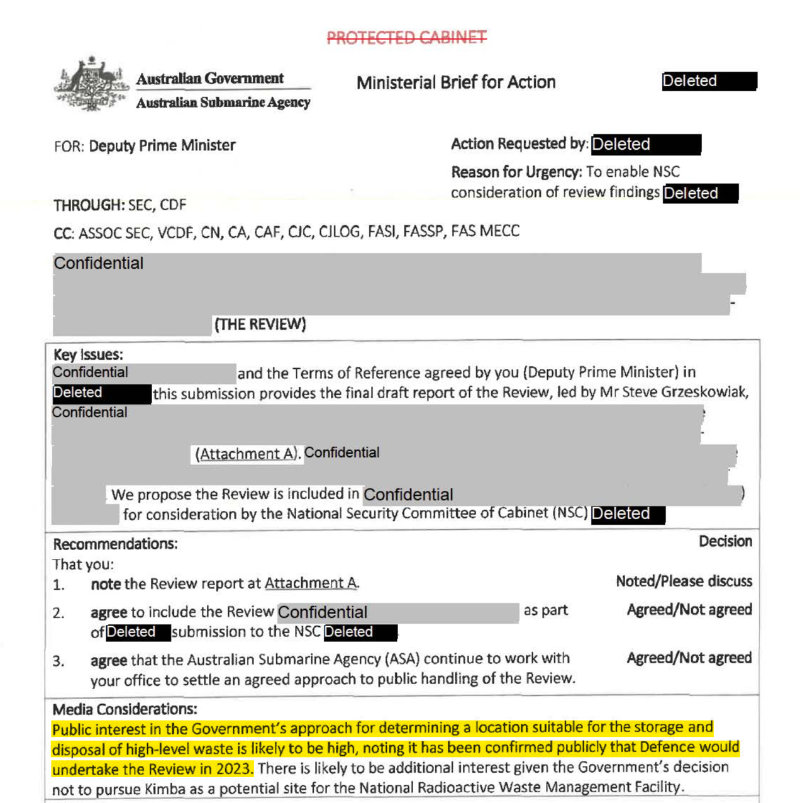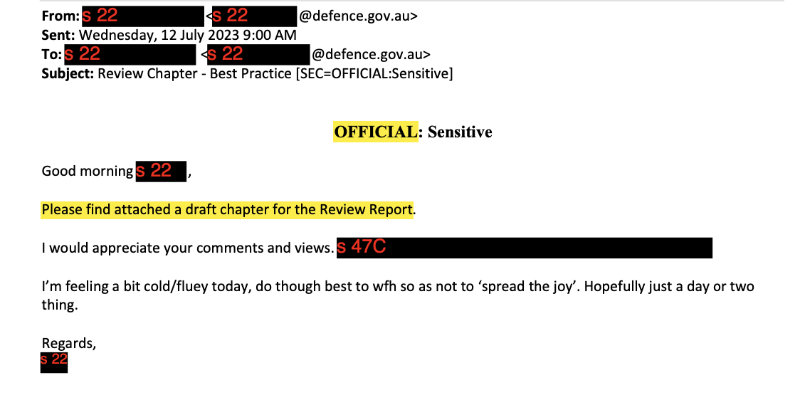Radioactive secrets. Fight to hide AUKUS nuclear waste sites gets absurd
Where to store nuclear waste from AUKUS submarines is a decision which will impact us for millennia, but they are going to extraordinary lengths to hide it from the public. Rex Patrick reports.
Somewhere deep inside a locked government filing cabinet within Australia’s labyrinthine Defence bureaucracy, there’s a document intended to advise the Government on what locations in Australia might be suitable to store high-level nuclear waste and how to select one of those locations.
It’s a roadmap to where the most toxic material on our planet may be dumped for tens of thousands of years. The report itself is just paper, but it’s red hot. It’s politically radioactive.
The document in question is the result of a $360,000 February 2023 contract to a company called SG Advice. The principal of SG Advice was tasked with coordinating the Australian Nuclear Science and Technology Organisation, the Australian Radioactive Waste Agency, the Australian Submarine Agency, Defence, and Geoscience Australia to produce a “significant piece of policy advice” for the government.
The document is being held secret despite the obvious fact that a decision on a location for a high-level nuclear waste facility will be a decision with impacts which will last for millennia.
The government doesn’t want the public to see it – it’s just too controversial. All the more reason then for me to seek access to it using our Freedom of Information laws.
A Cabinet document
When I requested the report, the newly minted Submarine Agency told me I couldn’t have it because it was a cabinet document. But when I thought about the nature and purpose of the report, this didn’t make sense.
The Cabinet Handbook, the authoritative rules governing all matters relating to Cabinet, states that “… Cabinet documents are … not the property of … [the] department. Access to them by succeeding governments is not granted …”
If this ‘significant piece of policy work’ dealing with the problem of high-level nuclear waste in a multi-decade program was a Cabinet document, it would only be available to the Department for the period that the Albanese Government was in power. If there was a change of Government, the work that was done would go into the archives and would not be available for reference by future governments, at least not for 20 years. So, the nuclear waste planning would have to be revisited from scratch.
But the Submarine Agency went to the Administrative Review Tribunal with its taxpayer funded lawyers to argue that the report was a Cabinet document and consequently must remain secret.
Government Ministers and bureaucrats love Cabinet-in-confidence exemptions because if they’re upheld, it’s ‘all over red rover’ as far as any public access is concerned. First Assistant Director-General of the Submarine Agency, Alexandra Kelton, deposed:
… my understanding at all times was that the final Review report would be a document submitted to the [National Security Committee of Cabinet] for its consideration.
If it was intended for Cabinet, then the Submarine Agency had engaged in wasteful administrative folly.
Document purpose
In order for the Tribunal to find that the report was a Cabinet document, it needed more than just evidence that it has been to Cabinet. The FOI Act demands that the Agency must show, with probative evidence, that the report was
brought into existence for the dominant purpose of submission for consideration by the Cabinet.
The only evidence before the Tribunal that the document was born with Cabinet submission in mind was in the $360,000 contract to SG Advice Pty Ltd which stated, “Any decision related to locations for the storage and disposal of radioactive waste is a decision for the Australian Government.”
Ms Kelton deposed, “The capitalised reference to ‘Australian Government’ in the [contract] is synonymous with Cabinet. That is a common expression in Defence and [the Submarine Agency] when referring to Cabinet.”
Instead of using the word ‘Cabinet’, Ms Kelton used the broader multi-definitional word “Australian Government”. She could have used “Cabinet” but she chose to be ambiguous.
The contract to commence the report was signed in late February 2023. The report was completed in November 2023. Only after the document was finalised was it sent to the Defence Minister, suggesting it should go to Cabinet. In the covering brief, the Submarine Agency raised the political sensitivity of the content of the report.

Recommendation that the Report be Taken to Cabinet (Source: Defence)
Despite the attempt by the agency to wrap the report in a 20-year-long secrecy blanket, it’s likely the Tribunal will rule in my favour and we will all get to see the report. It should not otherwise be kept secret.
Reckless conduct
The Submarine Agency will bear the ultimate responsibility for Australia’s nuclear stewardship under the AUKUS agreement and in relation to our nuclear non-proliferation obligations with the International Atomic Energy Agency. Those stewardship obligations include commissioning, operating, maintaining, and decommissioning reactors and disposing of their high-level waste.
The Submarine Agency promotes the idea that it will manage all nuclear activities safely, informed by international best practices. Yet its approach to the nuclear waste report shows otherwise.
If we indulge the Submarine Agency for a moment and believe that the nuclear waste report was for Cabinet, their conduct and care of this report has been reckless.
They’ve been playing fast and loose with rules that are laid down at the highest level of the Australian Government; rules approved by Prime Minister Albanese and the Cabinet Secretary, Attorney-General Dreyfus, and endorsed by Cabinet itself.
Ignoring the rules for convenience
The Cabinet Handbook states that it is inappropriate to provide copies of, or access to, final or draft Cabinet documents to sources external to government. Yet, in total disregard for that rule, the Submarine Agency contracted the consulting company SG Advice PTY LTD to lead the review and the report writing team.
Moving on, there exists a real-time, highly secure, whole of Australian government information and communications technology system used to support the Commonwealth’s end-to-end Cabinet process. It’s called CabNet+.
The Cabinet Handbook states Cabinet documents, including pre-exposure drafts, exposure drafts, drafts for coordination comments, final submissions, and drafting comments (including coordination comments), must only be circulated via the CabNet+ system to ensure that they are circulated securely and that copies of the documents can be accounted for.
It is important, therefore, that exposure drafts, drafts or finals (either in the template or in a document which looks like a Cabinet submission) are not circulated by any other means.
It goes on to state: Similarly, substantive comments on submissions should only be transmitted via CabNet+.
And yet all the work associated with the nuclear waste site report was carried out on standard departmental networks.
Much of the communication was only marked official (unclassified), including emails that contained drafts of the report. In response to the argument that the report could not be a Cabinet document because it was not prepared and stored on CabNet+ Ms Kelton deposed, “The process for planning and drafting the Review report was collaborative and iterative. As a matter of practicality for communicating and formatting parts of the draft, that process occurred outside the CabNet system.”

Report Sent on an Unsecured System (Source: FOI)
So, one of the most senior people in an Agency responsible for stewardship of high-level nuclear waste has indicated that it’s OK to depart from mandatory requirements.
How’s that for knocking people’s confidence in an organisation’s ability to manage highly radioactive nuclear material.
In the lead up to the hearing, the government’s lawyers threatened me not to reveal these details.
Stop the secrecy!
Yes, the report I’m after relates to a highly controversial topic and one of great importance. It relates to the location of an AUKUS spent nuclear fuel repository. But it’s a document that ought to be made public … and especially so because of its controversy.
Prime Minister Albanese insisted that Opposition Leader Dutton be transparent about the sites of his seven proposed nuclear power reactors.
Dutton obliged.
Yet Albanese has obstinately resisted disclosure of documentation about the location of a future High Level Nuclear Waste facility. It’s almost certainly politically radioactive, but politics is no justification for secrecy.
Moreover, this is a document that will inform government decisions of an indefinite character. Wherever the nuclear waste goes, it will go there for good.
The need for full public and expert scrutiny of this report is absolutely compelling.
Before he won high office, Anthony Albanese promised openness and transparency. Even if the nuclear waste report were a Cabinet document, he could authorise its release. That’s always in his power.
That he has refused to do so, sends my secrecy Giger Counter way into the red zone; maxed out by wilful obstruction and shameless hypocrisy.
Rex Patrick is a former Senator for South Australia and earlier a submariner in the armed forces. Best known as an anti-corruption and transparency crusader, Rex is running for the Senate on the Lambie Network ticket next year – www.transparencywarrior.com.au.
AUKUS: WHY WE SAY NO
from the Campaign for Nuclear Disarmament
What is AUKUS?
AUKUS is a military partnership between the UK, the US and Australia, that was signed between these three countries in September 2021. Billed as ‘a landmark defence and security partnership’, its key military focus centres on ‘the development of joint capabilities and technology sharing’, deeper integration of security and defence-related science, technology, industrial bases and supply chains.
It’s being justified on the basis of upholding the ‘rules-based order’, yet the treaty undermines the rules of international law.
Driving nuclear proliferation and breaking international law
Spreading nuclear technology is at the heart of the deal: the US and UK are collaborating with Australia to provide them with nuclear-powered submarines. Currently only six countries, all nuclear weapon states, have nuclear-powered subs (see Figure 1). Australia will become the seventh and the first non-nuclear weapons state to acquire nuclear reactors to power submarines. This risks nuclear proliferation and is a breach of the nuclear Non-Proliferation Treaty (NPT).
Boris Johnson argues that the AUKUS agreement does not contravene the NPT because the shared technology is for nuclear power, not nuclear weapons. The NPT does not stop the exchange of civil nuclear technology but it stipulates it must be ‘for peaceful purposes’. However, the exchange is not peaceful. The pact enables the transference of weapons-grade enriched uranium to power war-fighting submarines undertaking provocative actions in potential conflict in the Indo-Pacific region.
This is the second time in 2021 that the British government has breached the NPT. In March, its Integrated Review included a 40% increase in the nuclear arsenal – contravening its obligations to take steps to disarm.
The pact will also see the three countries sharing cyber capabilities, artificial intelligence and other undersea technologies. Australia will also secure long-range Tomahawk cruise missiles, and allow the US to station more troops in the north of the country.
AUKUS – a boost for the British nuclear industry?
The deal may also have commercial implications, with a possible boost for the British nuclear industry. Following a £210m subsidy from the British government, Rolls-Royce (whose factory is based in Derby) is urging Australia to buy small modular nuclear reactors for civil energy production as well as reactors to power the submarines – in spite of an Australian moratorium on nuclear energy. The government may also try to secure decommissioning contracts for the spent fuel, which would exacerbate the build-up of toxic radioactive waste at Sellafield: the Cumbrian site contains hundreds of tonnes of highly radioactive material build up over 60 years.
AUKUS – continuing military escalation against China
The AUKUS pact is a dangerous escalation in the West’s ongoing confrontation with China.
A decade ago, the US announced its ‘Asian pivot’ – refocussing US military, strategic and naval resources towards the Asia Pacific. Around 100,000 US troops are based across Japan, Australia, South Korea, Guam and Hawaii , and over 400 US bases encircle China (see Figure 2). This has intensified under the Biden administration. Earlier this year, he hosted the first-ever summit of the ‘Quad’ – a military alliance with Japan, Australia and India – to ‘meet challenges to the rules-based maritime order in the East and South China Seas’.
The 2021 Integrated Review of Security, Defence, Development and Foreign Policy , outlines the British government’s strategic ‘tilt’ to focus on the Indo-Pacific – building a network of allies with India, Australia and others against China. It broke with the 2015 Strategic Review which promoted closer relationships across the Asia Pacific.
In May, the HMS Queen Elizabeth aircraft carrier left Portsmouth for the South China Sea, accompanied by a major naval flotilla – the largest British naval and air taskforce since the Falklands war; it participated in provocative naval exercises with India, Japan, South Korea and Singapore as well as causing an international incident en route.
Indo-Pacific and nuclear colonialism
There is also a further colonial context to the British and US presence in the Indo-Pacific. John Pilger’s 2016 documentary ‘The coming war with China’ graphically illustrates the devastating impact of nuclear testing on the inhabitants and their islands, such as the Kiribati (Christmas), Malden and Marshall Islands, then under British and US colonial control in the 1950s. As well as the environmental devastation, islanders still suffer from the long-term impacts of the exposure to radiation, experiencing increased rates of cancer . In the mid-1980s states in the South Pacific declared the region a nuclear weapon-free zone, known as the Rarotonga Treaty . The AUKUS pact may well breach this Treaty.
AUKUS makes the world more dangerous
The AUKUS pact brings nuclear technology into an increasingly militarised part of the world, where accidents or further provocations could flare up into full-scale war.
Not surprisingly, China has strongly criticised the pact, with its foreign ministry spokesman, Zhao Lijian, saying the alliance risks “severely damaging regional peace… and intensifying the arms race”.
Indonesia and Malaysia have raised concerns the deal could lead to a regional arms race and Pacific nations, already ravaged by nuclear testing, say the whole region has been put at risk.
New Zealand will ban Australian submarines from its waters. Reaffirming the country’s nuclear-free policy, Prime Minister Jacinda Ardern, said ‘New Zealand’s position in relation to the prohibition of nuclear-powered vessels in our waters remains unchanged.’
War drives climate change
Military escalation against China is also diverting much needed resources away from cutting carbon emissions and halting the climate catastrophe. Scientists for Global Responsibility estimate that from 2021-2025, the British government will spend over seven times as much (£190.5bn) on the military as on reducing national carbon emissions (£25.6bn) (see Figure 3).
And the £205bn that the UK government is spending on replacing Trident could pay to install solar panels in every home or build enough wind turbines to power all households in the UK.
In fact, as the climate crisis gains pace, there will be increasing pressures on access to resources such as land, food and clean water, making war and nuclear conflict more likely.
Global cooperation and nuclear disarmament
Instead of this drive to a new cold war, which threatens to become a hot war with the real possibility of the use of nuclear weapons, we need global cooperation to tackle the very obvious threats of climate change and pandemics.
Governments across the world have shown it is possible to come together to develop nuclear-free zones: they exist in the South Pacific, Latin America and the Caribbean, Southeast Asia, Central Asia and Africa. This cooperation is going a step further with the UN Treaty on the Prohibition of Nuclear Weapons. It is the direction demanded by the global majority, not a new nuclear arms race.
Building opposition to AUKUS internationally and locally
CND is working in unity with partners in the peace movements in the US and Australia against AUKUS, and we want to build on that here. Our members, supporters and local groups have a central role to play in raising public awareness of AUKUS across the country; you can involve other peace and environmental organisations, trade unions and political parties, students and young people, to help mobilise opposition. Visit CND website to lobby your MP to support Early Day Motion 493 against AUKUS , and make use of the model motions for trade union and political party use.

